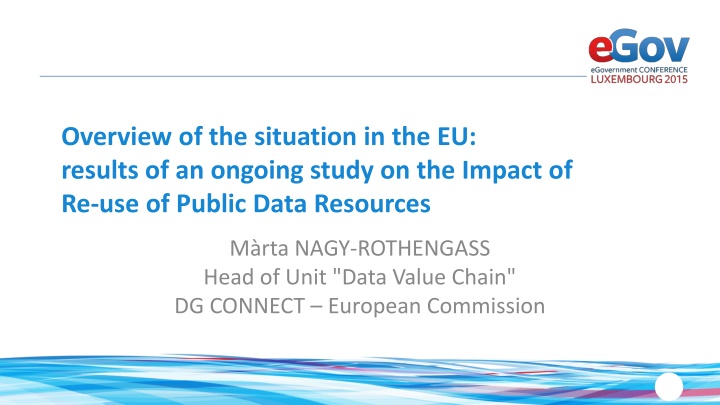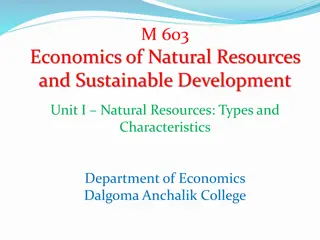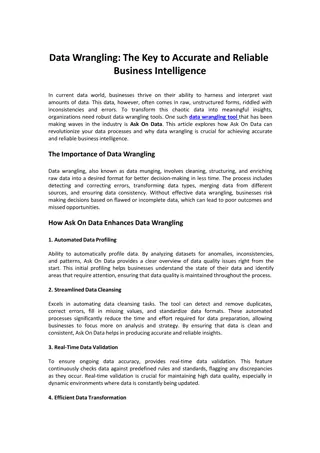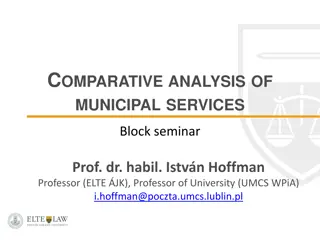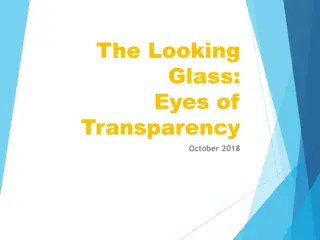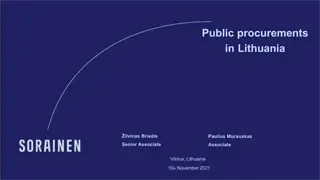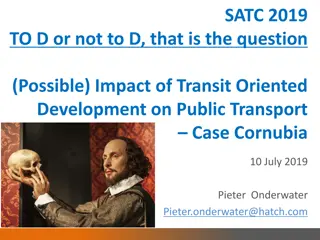Overview of the Impact of Re-use of Public Data Resources in the EU
Ongoing study on the impact of re-use of public data resources in the EU led by Marta Nagy-Rothengass, Head of Unit "Data Value Chain" at DG CONNECT, European Commission. The study examines the policy context, initiatives such as Open Data Communication, Directive adoption, and the Digital Single Market Strategy focusing on maximizing the growth potential of the digital economy through open data and addressing emerging issues like data ownership and access.
Download Presentation

Please find below an Image/Link to download the presentation.
The content on the website is provided AS IS for your information and personal use only. It may not be sold, licensed, or shared on other websites without obtaining consent from the author.If you encounter any issues during the download, it is possible that the publisher has removed the file from their server.
You are allowed to download the files provided on this website for personal or commercial use, subject to the condition that they are used lawfully. All files are the property of their respective owners.
The content on the website is provided AS IS for your information and personal use only. It may not be sold, licensed, or shared on other websites without obtaining consent from the author.
E N D
Presentation Transcript
Overview of the situation in the EU: results of an ongoing study on the Impact of Re-use of Public Data Resources M rta NAGY-ROTHENGASS Head of Unit "Data Value Chain" DG CONNECT European Commission
The policy context 2011 Communication on Open Data (COM(2011)882) Update of the Commission's decision on re-use (2011/833/EU) 2012 Launch of the EU Institutions' portal www.open-data.europa.eu 2013 Adoption of the Directive (2013/37/EU) amending the PSI Directive 2014 Commission Notice: guidelines on PSI re-use (2014/C 240/01) Commission Communication 'Towards a thriving Data-Driven Economy' 2015 Adoption of DSM Strategy: April 2015 Launch of the pan-European Open Data portal: November 2015 Review of the Commission's decision on re-use
Open Data and the Digital Single Market Strategy (I) In line with the strategy presented in the 2014 Big Data Communication, Open Data is part of the Data Economy Pillar III: Maximising the growth potential of the digital economy Building a data economy Free flow of data initiative Commission to focus on: Encouraging access to public data Tackling data location restrictions Clarifying emerging issues of data ownership, access and liability Launching a European Cloud initiative
Open Data and the Digital Single Market Strategy (II) Next steps: A. Launch of public DSM consultation on 'platforms, online intermediaries, data and cloud computing and the collaborative economy' https://ec.europa.eu/eusurvey/runner/Platforms/ Includes a question on PSI re-use B. Closes end 2015 C. Results available in February-March 2016
Open Data and the Digital Single Market Strategy (III) In the field of Open Data, the consultation is intended primarily as 'taking the pulse' exercise rather than preparation for a new policy initiative New initiatives can be expected in the 'emerging' fields of data localisation, data ownership and access Policy choices to be decided upon in the second half of 2016
Towards an infrastructure for (open) data (I) The Connecting Europe Facility (CEF) programme 2014-2020: "Access to digital service infrastructures are the elementary units of a digital single market, allowing communication, services and business to grow allowing areas such as e-commerce and e-government to exploit their full potential"
Towards an infrastructure for (open) data (II) Digital Service Infrastructures (DSIs) are deployed to deliver networked cross-border services for citizens, businesses and public administrations. Supported projects are to contribute to: Improvements in the competitiveness of the European economy; Promotion of the interconnection and interoperability of national, regional and local networks; Access to such networks, thus supporting the development of a Digital Single Market.
Towards an infrastructure for (open) data (III) The overall objective of the Open Data service infrastructure is to help boost the development of information products and services based on the re-use and combination of open public data, across the EU. The Open Data infrastructure, through its pan-European portal, provides an interface for accessing infrastructures distributed over a huge number of EU and MSs data repositories. The infrastructure as such provides a technical platform for data discovery and access, together with tools facilitating data transformation and exploitation.
Towards an infrastructure for (open) data (IV) Already launched actions are not limited to the portal. A series of support activities take place to support EU Countries publishing more data The objective is to provide common and tailored support to countries to accelerate the release of public data at national and local levels
Fostering the reuse of public data resources Four complementary work streams are focused on reuse: Leveraging community engagement to make the most out of Open Data Communicating and raising awareness about the Portal Preparing for the future and working on the sustainability Studying the economic impact of the reuse of public data resources Economic Benefits of Open Data Metrics to measure economic impact Market Size Jobs Created Cost Savings Efficiency Gains
Economic analysis core study Four indicators have been measured: Market Size and value added as percentage of GDP: the market size is defined through the market volume (realized sales volume ) and the market potential. Number of Jobs Created: number of additional jobs (in persons) created directly related to Open Data for the private sector. Cost Savings for the public sector: savings include time saved for public administrators by using Open Data, eliminated transaction costs for providing data, realizing more transparency. Efficiency Gains or productivity gains: qualitative assessment of indirect benefits for citizens. This can be in terms of time saved, lives saved, productivity gains.
Economic analysis main results (I) For 2016, the direct market size of Open Data is expected to be 55.3 bn EUR for the EU 28+. Between 2016 and 2020, the market size is expected to increase by 36.9%, to a value of 75.7 bn EUR in 2020. The total market value of Open Data is estimated between 193 bn EUR and 209 bn EUR for 2016 with an estimated projection of 265-286 bn EUR for 2020
Economic analysis main results (II) The forecasted total number of direct Open Data jobs in 2016 has an upper bound of 75,000 jobs. By 2020, the upper bound provides a forecast of just under 100,000 direct jobs directly related to Open Data jobs. This equals a growth of 32% over a 5-year period. Per year, the increase in number of jobs is forecasted to grow at an average rate of 7.3%. Thus, in the period 2016-2020, almost 25,000 direct Open Data jobs should be created
Economic analysis main results (III) Based on the forecasted EU28+ GDP for 2020, whilst taking into account the countries respective government expenditure averages, the cost savings per country have been assessed. The accumulated cost savings for the EU28+ in 2020 are forecasted to equal 1.7 bn EUR.
Economic analysis main results (IV) The metric efficiency gains has a more qualitative approach compared to the other three metrics. It offers a combination of the insights around the efficiency gains of Open Data and real-life examples. Three indicators are assessed in more detail: contribution to life saving, to time saving and to environmental benefits. The study evaluated that: Open Data has the potential of saving 1,425 lives a year (i.e. 5,5% of the European road fatalities). Applying Open Data in traffic can save 629 million hours of unnecessary waiting time on the road in the EU
Economic analysis conclusions and recommendations The costs and benefits of releasing data should be further detailed A marginal or free cost model for Open Data is needed Government Portals should maintain site analytics in order to obtain important information on who uses the websites, which data sets are being downloaded and how many downloads take place On Open Data portals, feedback mechanisms should be created Governments should conduct surveys into the re-use of Open Data in the private sector The work force should be empowered to make the most of Open Data
Thank you for your attention Creating Value through Open Data: http://www.europeandataportal.eu/en/content/creating-value-through-open-data European Data Portal: http://www.europeandataportal.eu/ ...and more: https://ec.europa.eu/digital-agenda/en/content-and-media/data Contact us at: cnect-G3@ec.europa.eu Follow us on Twitter: @EUDataEcosystem 17
